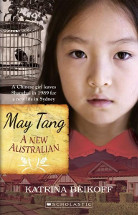May Tang: a new Australian by Katrina Beikoff

A New Australian series. Omnibus, 2017. ISBN 9781742990743
(Age: 10-12) Highly recommended. Themes: Immigration, Chinese in
Australia, Chinese History. Eleven year old May Tang's familiar life
in Shanghai is about to change. Her oldest brother Peter is settled
in Sydney, studying at university. The year is 1989 and Chinese
students are campaigning for democracy, for freedom of the press and
political change. May is unaware of the real reasons that Peter was
sent to Australia. She enjoys going to the park with her grandfather
Ye Ye, listening to his stories and his beautiful singing bird. At
home, her older sister Jie Jie bosses her around, always telling her
what to do. May is a dreamer, she loves her Chinese life, her
mother's cooking, the little street stalls and the sights and smells
of her city. May begins to understand when her mother shares her
story about the government's taking her out of uni and sending her
to work on a farm and reading Peter's letter about a better life in
Australia. Her father shares the news about the terrible turmoil in
Tiananmen Square and Peter's political activism, so the family
decide to send mother and daughter to Australia for safety.
Everything is strange and different in this new big city; she is
reluctant to leave the airport. Peter settles them in an apartment
and then leaves to work picking cherries in the country. May has to
be the adult, interpreting for her mother, helping her find a job
and face the difficulties of attending a new school. Here, she is a
victim of bullying and racist views, and when taunted for her
Chinese ways she becomes very unhappy. When she meets a new friend
Jade she finds acceptance and encouragement as she learns to believe
in herself.
May Tang is the sixth novel in the A New Australian series
exploring a specific historical period and the impact on a girl and
her family immigrating to Australia. Katrina Beikoff's novel
interweaves factual information with a beautifully detailed story.
She realistically captures both the Chinese and Australian ways of
life; the sights and smells of Sydney's Chinatown, the eighties
clothing - shoulder pads, the big hairstyles - crimped and curled,
even the birds are so different. With relatable characters,
realistic settings and slices of history these novels are suitable
for Middle Primary classes studying Australian History and
immigration.
Rhyllis Bignell